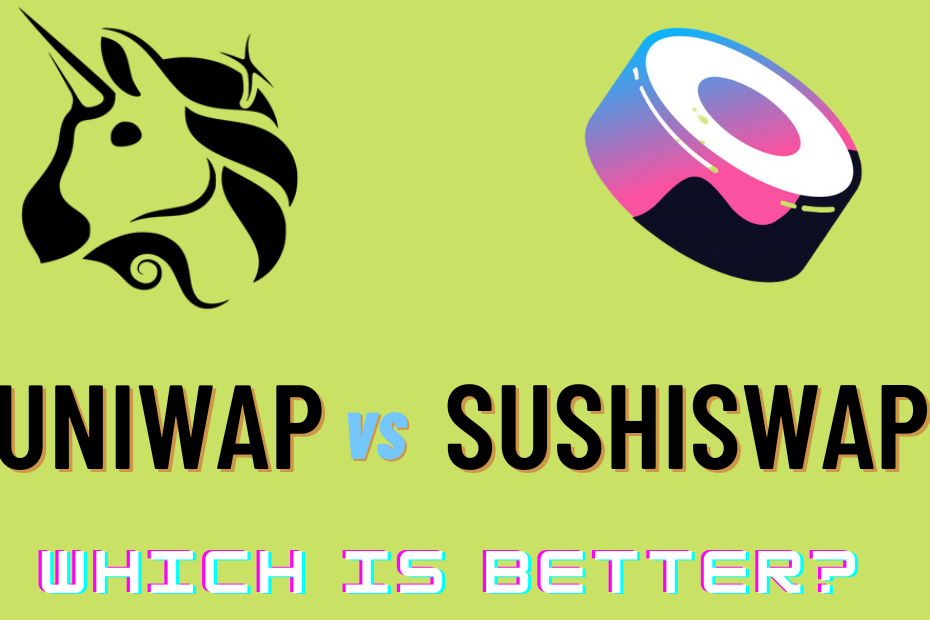Uniswap vs Sushiswap – Which Platform is Better?
Uniswap and SushiSwap, are two rival Ethereum (ETH)-based decentralized exchanges (DEXs). They are the two most essential DEXs in the decentralized finance (DeFi) space. DEXs allow users to swap assets without passing custody to third parties, eliminating the security risks associated with centralized exchanges.
Furthermore, because there is no Know Your Customer (KYC) authentication, DEXs enable improved anonymity and are immune to censorship because no single entity can interfere with the transactions. This article covers everything there is to know about sushiswap vs uniswap, so you can decide which platform is best for you.
What Is SushiSwap?
SushiSwap is a fork or replica of Uniswap launched in late August 2020 by the unknown “Chef Nomi.” SushiSwap, like Uniswap, is an AMM-based DEX. SushiSwap’s development team made a few changes to the source code, but the core product remains the same. Hayden Adams once accused SushiSwap of being a clone attempting to “steal” value from Uniswap. He was correct, as the platform quickly stole over $1 billion in locked value from Uniswap.
What is the SUSHI Token?
SUSHI is the native token of SushiSwap. The platform governs with SUSHI coins and gives them as incentives to liquidity providers. SushiSwap now mints several SUSHI tokens per block, split evenly among all pools. The number of SUSHI tokens created for every block declines over time and will reach zero once the maximum supply of 250 million tokens is gone. SUSHI is trading at $7 per token, with a circulating supply of 192 million tokens and a market capitalization of $1.3 billion.
What Is Uniswap?
Uniswap is a decentralized exchange (DEX) founded by Hayden Adams in 2017 that popularized the automated market maker (AMM) approach. In this concept, intelligent contracts create liquidity pools of ERC-20 tokens that are automatically exchanged according to a predefined algorithm. Anyone can utilize the collections as a DEX to exchange cryptocurrency for a minimal charge. Furthermore, users can act as liquidity providers by depositing cryptocurrency into liquidity pools and earning swap fees as an incentive.
What is the UNI Token?
In mid-September 2020, Uniswap introduced UNI, its governance token. At its inception, the platform coined 1 billion UNI, which will gradually enter circulation over the next four years. The UNI coins were distributed to the community during the original launch via an airdrop and liquidity mining. UNI is trading at $18 per token, with a circulating supply of 520 million tickets and a market capitalization of $9.4 billion.
Which is a Better Investment, SUSHI or UNI?
Sushiswap vs uniswap: Uniswap and SushiSwap are the top two DEXs in the DeFi field. This section compares the two platforms based on DeFi measurements to assess their performance in recent months. Total value locked (TVL) or liquidity, total transaction volume, and income are the essential indicators in the comparison.
- Revenue
Revenue is the entire value created by a platform via transaction processing. It is yet another essential statistic that defines a platform’s success. Uniswap again takes the lead, with monthly revenue consistently bigger than SushiSwap’s. SushiSwap, on the other hand, has been steadily gaining traction since its inception. SushiSwap’s revenue accounted for just 14 per cent of the overall revenue generated by both platforms in September 2020. Still, by June 2021, SushiSwap had generated 36 per cent of the total revenue of both platforms.
- Total Value Locked (TVL)
The total amount of assets locked behind DeFi intelligent contracts is called total value locked (TVL) or total liquidity. A high TVL indicates that many users have staked their cryptocurrency in DeFi. It is one of the most widely utilized metrics for determining how much value is being used or is accessible for usage across a platform.
During its launch near the end of August 2020, SushiSwap managed to gain the lead in TVL. As previously stated, this was due to the platform syphoning Uniswap’s liquidity by providing SUSHI awards that Uniswap did not have at the time. Uniswap, on the other hand, battled back in mid-September 2020 by issuing the UNI token, which increased its TVL above $2 billion, defeating SushiSwap. Uniswap currently has a greater TVL of $4.0 billion, while SushiSwap has $3.4 billion.
- Trade Volume
The entire value of deals on a platform is referred to as trade volume. It is another essential statistic that describes the success and growth of a forum. Uniswap currently leads the pack with a weekly trade volume of $7.7 billion, which is more than 700% greater than SushiSwap’s transaction volume of $1 billion. Uniswap has a daily trade volume of more than $1 billion. However, SushiSwap’s trade volume is constantly lower than Uniswap’s.
Conclusion
SushiSwap and uniswap are two highly comparable platforms. Both are AMM-based DEXs with token swapping via liquidity pools (for a fee). The swap charge is also a compensation for liquidity providers who supply liquidity to the collections on both platforms.
In terms of total value locked, trading volume, and revenue earned, Uniswap is now the leading DEX platform. SushiSwap is ranked second. SushiSwap’s real value is closed, and trading volume is comparatively low compared to Uniswap. However, its revenue is gradually increasing in a catch-up trend.
For more articles visit trendsoncrypto
